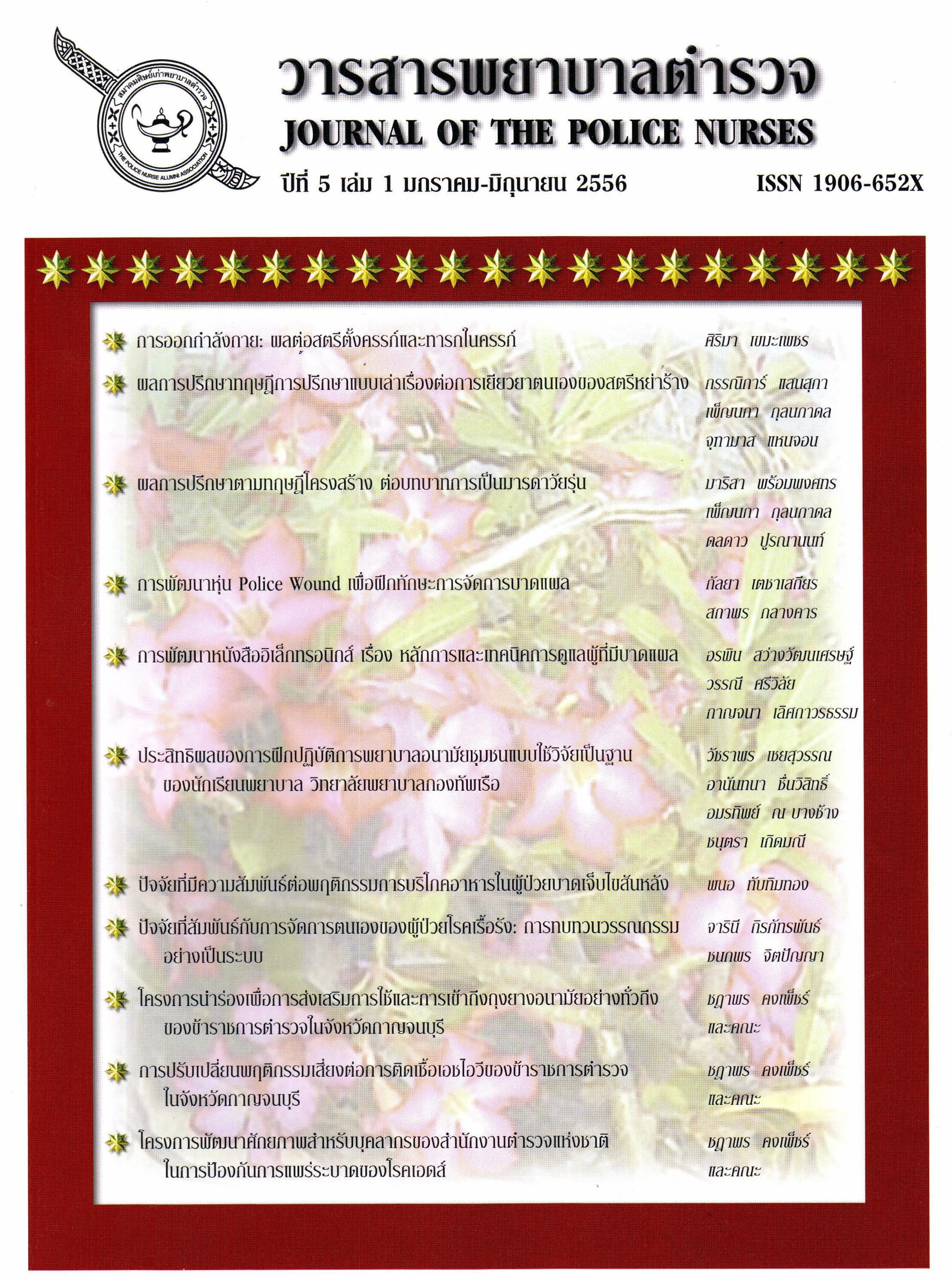การพัฒนาหนังสืออิเล็กทรอนิกส์ เรื่อง หลักการและเทคนิคการดูแลผู้ที่มีบาดแผล
Keywords:
หนังสืออิเล็กทรอนิกส์, หลักการและเทคนิคการดูแลผู้ที่มีบาดแผล, Electronic book, Principles and Technique of Wound CareAbstract
บทคัดย่อ
การจัดการเรียนการสอนในหัวข้อหลักการและเทคนิคการดูแลผู้ที่มีบาดแผล จัดให้มีการเรียนการสอนทั้งภาคทฤษฎีและภาคทดลอง เมื่อประเมินผลสัมฤทธิ์ทางการเรียนจากการสอบทักษะการทำแผล พบว่านักศึกษาร้อยละ 30 สอบไม่ผ่านทักษะนี้ จากการสอบถามความคิดเห็นของนักศึกษา นักศึกษาบอกการฝึกซ้อมโดยใช้คู่มือที่ไม่เห็นภาพ ไม่เห็นวิธีการทำ ทำให้ไม่มั่นใจในการปฏิบัติทักษะ จากเหตุดังกล่าวผู้วิจัยจึงได้สร้างหนังสืออิเล็กทรอนิกส์ขึ้นเพื่อใช้เป็นสื่อเสริมการเรียนการสอน มุ่งหวังพัฒนาความสามารถผู้เรียนให้ผู้เรียนบรรลุจุดมุ่งหมายการเรียนรู้ โดยมีวัตถุประสงค์ของการวิจัยเพื่อ 1) พัฒนาหนังสืออิเล็กทรอนิกส์เรื่องหลักการและเทคนิคการดูแลผู้ที่มีบาดแผล ที่มีประสิทธิภาพ ตามเกณฑ์ประสิทธิภาพ E1/E2 เท่ากับ 75/75 2) ศึกษาความพึงพอใจของนักศึกษาหลังการเรียนด้วยหนังสืออิเล็กทรอนิกส์เรื่องหลักการและเทคนิคการดูแลผู้ที่มีบาดแผล กลุ่มตัวอย่างที่ใช้ในการวิจัยครั้งนี้ คือนักศึกษาพยาบาลศาสตร์ ชั้นปีที่ 2 วิทยาลัยพยาบาลบรมราชชนนี ราชบุรี ที่ลงทะเบียนเรียนในรายวิชาหลักการและเทคนิคการพยาบาล ในภาคเรียนที่ 1 ปีการศึกษา 2554 จำนวน 40 คน สถิติที่ใช้ในการวิจัย ได้แก่ ค่าเฉลี่ย และค่าส่วนเบี่ยงเบนมาตรฐาน
ผลการวิจัยพบว่า 1) หนังสืออิเล็กทรอนิกส์เรื่องหลักการและเทคนิคการดูแลผู้ที่มีบาดแผล ที่สร้างขึ้นมีประสิทธิภาพตามเกณฑ์ E1/E2 = 77.22/76.22 2) นักศึกษามีความพึงพอใจต่อหนังสืออิเล็กทรอนิกส์โดยรวมมีค่าเฉลี่ยมากที่สุดคือ 4.71 โดยมีความพึงพอใจมากที่สุดในด้านเนื้อหา ค่าเฉลี่ย 4.80 รองลงมา คือ ด้านเทคนิคการผลิตสื่อ ค่าเฉลี่ย 4.61
ผู้สอนสามารถนำหนังสืออิเล็กทรอนิกส์ที่ผู้วิจัยจัดทำขึ้นไปใช้ในการมอบหมายงานแก่นักศึกษาให้ศึกษาเพิ่มเติมและตอบคำถามตามใบงาน วิธีการนี้จะช่วยพัฒนาความสามารถของผู้เรียนในทักษะการทำแผล การพันผ้า การประคบร้อนและการประคบเย็น
คำสำคัญ: หนังสืออิเล็กทรอนิกส์; หลักการและเทคนิคการดูแลผู้ที่มีบาดแผล
Development of the Electronic Book on Principles and Technique
of Wound Care and Learning Outcomes
Abstract
Principle and Technique of Wound Care topic was designed for nursing students to learn in their classrooms and laboratories. The results of learning and training evaluation found that 30% of the students failed in wound care techniques and skills because they do not recognize the step of wound care procedures. Therefore, the researchers developed the electronic book on Principle and Technique of Wound Care topic as a complementary instrument. This electronic book consists of images, video and content text aimed to help students to develop their wound care techniques and skills.
The purposes of this study were 1) to develop the electronic book on Principle and Technique of Wound Care based on the efficiency criteria of 75/75 and 2) to identify nursing student satisfaction on electronic book. 40 nursing students of Boromarajonani College of Nursing Ratchaburi who study Principle and Nursing Technique in the first semester, year 2011 were recruited to this study. Mean and standard deviation were undertaken.
The results found that 1) the efficiency of the electronic book on Principle and Technique of Wound Care passed the efficiency criteria (E1/E2=77.22/76.22 2). The mean total student satisfaction score on electronic book was 4.71 (SD =0.05); content of electronic book has a highest satisfaction score (mean =4.80, SD=0.43), and followed by techniques used to develop the electronic book (mean =4.61, SD=0.56)
The researchers suggested that nursing instructors should give their students assignments to study Principle and Technique of Wound Care topic via electronic book. This instrument will help nursing students to develop their wound care techniques and skills.
Keywords: Electronic book; Principles and Technique of Wound Care
Downloads
Downloads
How to Cite
Issue
Section
License
ผลงานที่ได้ตีพิมพ์แล้วจะเป็นลิขสิทธิ์ของวารสารพยาบาลตำรวจ



